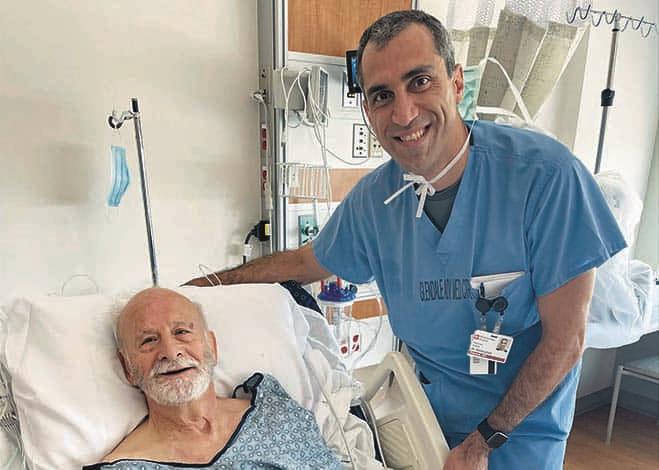
An Abdominal Aortic Aneurysm & Lifesaving Vascular Repair
Last year, Glendale resident Archie Zeinali had a routine CT scan for a hernia in his abdomen. What doctors found was a far more pressing concern: an abdominal aortic aneurysm. An aortic aneurysm is a balloonlike bulge in the aorta — the largest artery in the body — caused by weakness in the blood vessel’s wall. Zeinali’s aneurysm was near his kidneys, where the aorta splits into two branches.
While many people can live with an aneurysm for years with no complications, a ruptured aneurysm can cause fatal internal bleeding. “In many cases, it’s vital to repair the aneurysm before it ruptures,” says Edward Samourjian, MD, the vascular surgeon who repaired Zeinali’s aneurysm. “If it ruptures, it’s an emergency situation — nearly 50 percent of people die at home before they can even get medical help.”
Luckily for Zeinali, Adventist Health Glendale has an expert vascular surgery team that provides complex, lifesaving aneurysm repairs right here in Glendale.
Abdominal Aortic Aneurysm Symptoms
Often, as in Zeinali’s case, an aneurysm causes no symptoms. “Sometimes you might feel a pulsing sensation in your abdomen that indicates an aneurysm,” Dr. Samourjian says. Other symptoms may include constant pain in the abdomen or back. Aneurysms can be caused by plaque buildup inside the arteries, sustained high blood pressure or traumatic injuries.
A Complex Stent Procedure
“Most aneurysm repair procedures are pretty standard. You can fix them by inserting a stent, which is a flexible tube, in the aorta to heal the blood vessel,” Dr. Samourjian says. Because Zeinali’s aneurysm was close to his kidneys, however, he was not a candidate for a traditional operation.
“Normally, when the aneurysm is this close to the kidney arteries, we would have to do an open abdominal surgery,” Dr. Samourjian says, noting that this can be complicated and lead to more pain and a longer recovery time. A new technology has allowed skilled surgeons to place a special stent close to the kidneys through small incisions, without opening the abdomen. “It’s a complex procedure, and it had never been done at Adventist Health Glendale,” Dr. Samourjian says. “It’s so nice to be able to offer this procedure. Now people know you don’t have to go to major university hospitals for advanced surgery.”
Though he knew the operation was complex, Zeinali says, “I trusted Dr. Samourjian to handle the procedure with care. Every doctor I spoke to said he’s great, and they were right.”
Recovery With A Personal Touch
Because his surgery was minimally invasive, done through small incisions with precise tools, Zeinali could go home just one day later. “I had very little pain the first day,” he says. “The next day, I had no pain at all, and a week later I was back to normal.”
Although Zeinali was home from the hospital, he never felt alone in his recovery. “Every week, Dr. Samourjian called to ask how I was feeling,” he says. “He had a very good attitude.”
Indeed, Dr. Samourjian enjoys staying in touch with former patients to ensure they feel cared for and are recovering well. “We’re a close-knit community,” Dr. Samourjian says, “and I want my patients to know that I care.”
World-class Vascular Care Close To Home
The vascular surgery team at Adventist Health Glendale provides advanced, innovative surgical procedures right in your neighborhood, with personalized care that sets them apart.
Talk to the team of experts at Glendale Heart & Vascular Institute about a personalized treatment plan. Visit AdventistHealth.org/Doctors to find a provider.



